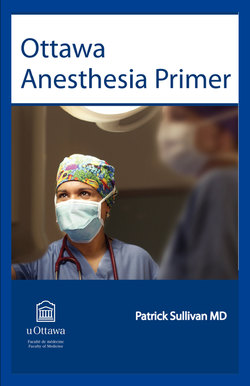Читать книгу Ottawa Anesthesia Primer - Patrick Sullivan - Страница 11
На сайте Литреса книга снята с продажи.
Anesthetic Modalities:
ОглавлениеThe delivery of regional anesthesia (RA) refers to the application of a local anesthetic agent to the nerves supplying the anatomical area of surgical interest. Broadly speaking, regional anesthesia is divided into central (neuraxial) and peripheral (nerve block) techniques. These techniques involve the application of a local anesthetic to a specified region to prevent the transmission of pain signals. Finally, monitored anesthetic care refers to anesthetic monitoring with or without the administration of intravenous sedation. Procedures under monitored anesthetic care are commonly performed with intravenous sedation and local anesthesia.
Anesthetic Modalities Include:
1 Local anesthesia + monitored anesthetic care
2 Sedation + monitored anesthetic care
3 General anesthesia (GA) Combined intravenous and inhalational anesthesia (e.g., laparotomy
4 Inhalational anesthesia (e.g., myringotomy)
5 Intravenous anesthesia - total intravenous anesthesia (TIVA) (e.g., neurosurgery, malignant hyperthermia)
6 Regional anesthesia (RA)Brachial plexus block (e.g., interscalene, infraclavicular, axillary blocks)Femoral nerve blockPopliteal nerve blockTransversus abdominis plane block (TAP) blockLocal Blocks: Ankle block, Bier blockMajor Regional anesthesia:Neuraxial anesthesia (spinal, epidural, and combined spinal/epidural anesthesia)Spinal anesthesia: (e.g., total hip arthroplasty, Cesarean delivery)Epidural anesthesia: (e.g., epidural analgesia for labour and delivery)Combined spinal/epidural anesthesia: (e.g., femoral popliteal bypass surgery)
7 Combined RA + sedation
8 Combined GA + RA
The challenge in anesthesia is to choose the most appropriate modality for a patient undergoing a surgical intervention while maintaining an equilibrium between the stress of the surgical procedure and the cardiorespiratory depressant effects of the anesthetic. Thus, modern anesthesia uses a combination of medications in an attempt to minimize the adverse effects and maximize potential benefits of each drug. These medications may include opioids to blunt the pain response to surgery, propofol to induce an anesthetic state, and volatile anesthetic agents to maintain anesthesia. Other common anesthetic medications include benzodiazepines, vasoactive medications, antiemetics, and neuromuscular blocking agents.
In order to formulate an anesthetic plan, the anesthesiologist must consider both the patient’s medical condition and the proposed surgical procedure. Patient factors include patient preferences, previous anesthetic experiences, presenting illness, medical history, as well as the patient’s medications and allergies. During a physical examination, particular attention is paid to the patient’s airway and cardiac and respiratory systems. Each surgical procedure has its own set of anesthetic considerations that need to be balanced with the patient’s physiologic status. Procedures may be performed with local anesthesia alone, monitored anesthetic care, regional anesthesia, general anesthesia, or a combination of these choices (e.g., combined epidural and general anesthesia). It is only after considering the patient’s preferences, medical condition and the surgical procedure that a reasonable decision can be made regarding the choice of anesthetic modality best suited to the patient’s operative procedure.
